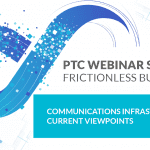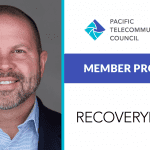The International telecoms industry is a relationship-based business and that is one of its best aspects. We do business with people we know and that we can trust. It isn’t like other IT segments where you can buy what you need with a credit card and spin up a service.
There’s a deeper level of engagement and that is why the last 12 to 18 months have been challenging for a lot of the international telecoms community. From sales guys to CEOs, they’ve all been frustrated and longing to hit the road again to meet people in person.
The challenge has been to engage new prospects and nurture customers while there have been very few in-person events or meetings. It is difficult to build new relationships when you can’t book a meeting over a coffee and talk about each other’s businesses.
It is time for the companies that enable digital transformation to become increasingly digitally enabled themselves. This isn’t about an “all or none” approach to marketing, but instead thinking about how dialling up online channels can support offline sales.
Lockdowns and quarantines associated with COVID-19 have created an opportunity to transform how carriers market and sell their services. They can explore efficient ways to develop new relationships, and most importantly, ensure prospects know their business before sales teams even pick up the phone.
Turning Purpose into Profit
It starts with the carrier’s purpose – not what they are selling, but what value they are delivering in the market. Carriers that communicate a strong sense of purpose, rather than just talking about products, are easier to build relationships with. “We make connectivity simple,” or “Maximize the value of every minute and message on your network,” or “We’re creating the next digital hubs” are all more compelling than selling DCI, telecoms data, or data centre space.
A carrier’s purpose should be laced into all content and communications and amplified across LinkedIn. A consistent brand narrative and messaging will define a business in the minds of prospects online and offline.
Blogs, eGuides, news, LinkedIn posts, and articles shape perception and confirm if the business can provide what a prospect needs and if they are a legitimate business. Even if a prospect doesn’t read any of the content, they’re seeing what the business stands for and what its purpose is. Just producing this level of quality content conveys that your business is legitimate.
In the best scenario, a carrier actively creates content that supports inbound lead generation, which either offers helpful advice or solves a challenge that customers are facing. At the same time, they’re using media to deliver their news to create momentum and milestones that demonstrate what value they have in the market. They develop an ecosystem of touchpoints that create opportunities to start relationships and build trust with prospects. All these touchpoints shape offline conversations and accelerate sales journeys.
Scaling Conversations
The most important aspects of a content strategy are scalability and cost-efficiency, compared to cold calling or sending sales teams out to have individual conversations. Carriers that were able to hit their sales targets in 2020 without using their travel budget will find it extremely difficult to return to pre-COVID spending.
Every sales team has a finite number of team members and hours in the day. They can’t have hundreds of sales conversations per month. Carriers must look at ways to ensure that each in-person meeting is highly productive and time allocated to travel has a significant return on investment. Otherwise, they’re using a traditional model that is resource-intensive and is difficult to scale.
We’ve also seen new interest in using local agents around the world to support sales while travel has been off limits. That’s a solution that can be costly and relies on the carrier’s trust of the agent. It’s more like putting a band-aid on the underlying issue, which is that ultimately, buyers are getting used to digital experiences and expect to have some sort of online engagement before getting fully into the sales journey.
Cool Operators
Coolwave Communications is a great example of a business transforming its brand and online presence to efficiently scale sales efforts. It started with a basic website and a sales team with decades of relationships to rely on. The team could see the potential to do more to kick off new relationships and start engaging beyond their European footprint.
Coolwave started by locking in a really compelling story and repositioning itself with new messaging. It needed to accurately demonstrate where they’re at as a business and show who they are, not just say it in meetings. After that, it redeveloped its website, started consistently communicating its milestones via emailers and press releases, then began capturing leads off its website using HubSpot. Getting the brand narrative and messaging locked in was key, then delivering it consistently guaranteed success.
The result has been core accounts coming to them rather than needing to be chased. The digital approach is fully aligned with its in-person meetings and events strategy. The team has been able to scale-up the number of touchpoints it has to start conversations, then close deals on calls, in-person, and increasingly at events.
The next step is to launch a self-service portal on the website where 2-way voice services can be ordered online. This enables customers to start the sales process themselves and then speak to sales reps and support teams as and when needed. It’s the customer’s choice in how they want to engage.
Balanced Budgets
As COVID restrictions are lifted, many carriers will return to events but prioritize the really key events on the calendar like ITW, PTC’22, Capacity Europe, and Capacity Middle East. They’ll take a more balanced approach to offline and online sales and marketing, while reducing dependence on in-person meetings. The value of each of these events will increase when a carrier has initiated conversations online and there’s an awareness and understanding of the business built over the previous 12 months.
If anything, COVID has forced many carriers to reassess how they approach marketing and refocus on online channels and that will ultimately lead to efficient use of budget and a scalable approach.
Ilex Content Strategies
Ilex Content Strategies is a global B2B Marketing and Communications agency serving technology and telecoms companies, from start-ups through to billion-dollar businesses. Its clients specialise in cybersecurity, cloud, enterprise IT, local and global networking, mobile, SaaS, and a whole range of innovative solutions. Ilex Content Strategies’ clients span Asia, the Middle East, Africa, Europe, and the Americas.
Ilex uses compelling content to give our clients the multiple touch points they need to influence their audiences and accelerate their growth.
Innovation demands communications.









